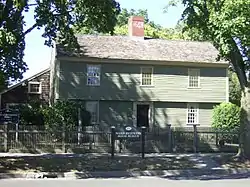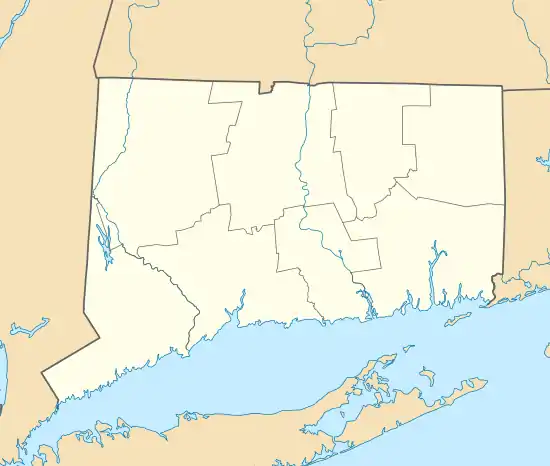Ward-Heitman House
The Ward-Heitman House is a historic house museum at 277 Elm Street in West Haven, Connecticut. Built on or before 1725, it is believed to be the oldest standing house in the former territory of the New Haven Colony. Its rooms house displays of furnishings and objects that might have been used by families that lived here in more than 250 years of residential occupancy. The house was listed on the National Register of Historic Places in 2003.[1]
Ward-Heitman House | |
 | |
  | |
| Location | 277 Elm St., West Haven, Connecticut |
|---|---|
| Coordinates | 41°16′34″N 72°57′08″W |
| Area | 0.5 acres (0.20 ha) |
| Built | 1725 |
| Built by | Ebenezer Clark |
| Architectural style | Colonial |
| NRHP reference No. | 02001691[1] |
| Added to NRHP | January 8, 2003 |
Description and history
The Ward-Heitman House is located north of the center of West Haven, occupying 0.5 acres (0.20 ha) on the north side of Elm Street between Campbell Avenue and Ward Place. It is a 2+1⁄2-story timber-frame structure, with a heavy post-and-beam frame finished in wooden clapboards and covered by a gabled roof. It has a three-bay front facade, with sash windows arranged symmetrically around the main entrance. The second story has a slight overhang, and there is a large brick chimney at the center of the building. One ell extends to the rear, and a second extends to the west side. A 20th-century addition which extended to the east has been removed. The interior of the main block was originally two rooms on each floor, separated by the chimney. A narrow vestibule in front of the chimney includes a winding staircase typical of 17th and early 18th-century First Period houses.[2]
The house's exact construction date is not known. It is known that this house was standing on this property by 1725, and the building's construction methodology suggests it may date as far back as 1680. It was most likely built by Ebenezer Clark, who owned the land in this area at that time through his marriage to Rebecca Brown, daughter of Ebenezer Brown, the first colonial grantee. The property was acquired by Thomas Ward in 1788, and his descendants (including the Heitmans) remained on the property until 1909. It went through a number of owners in the 20th century, before being given to the National Trust for Historic Preservation in 1995. The trust deeded the property to a local nonprofit, which now operates it as a historic house museum.[2]
References
- "National Register Information System". National Register of Historic Places. National Park Service. November 2, 2013.
- "National Register of Historic Places Inventory/Nomination: Ward--Heitman House". National Park Service. Retrieved June 11, 2021. With accompanying pictures